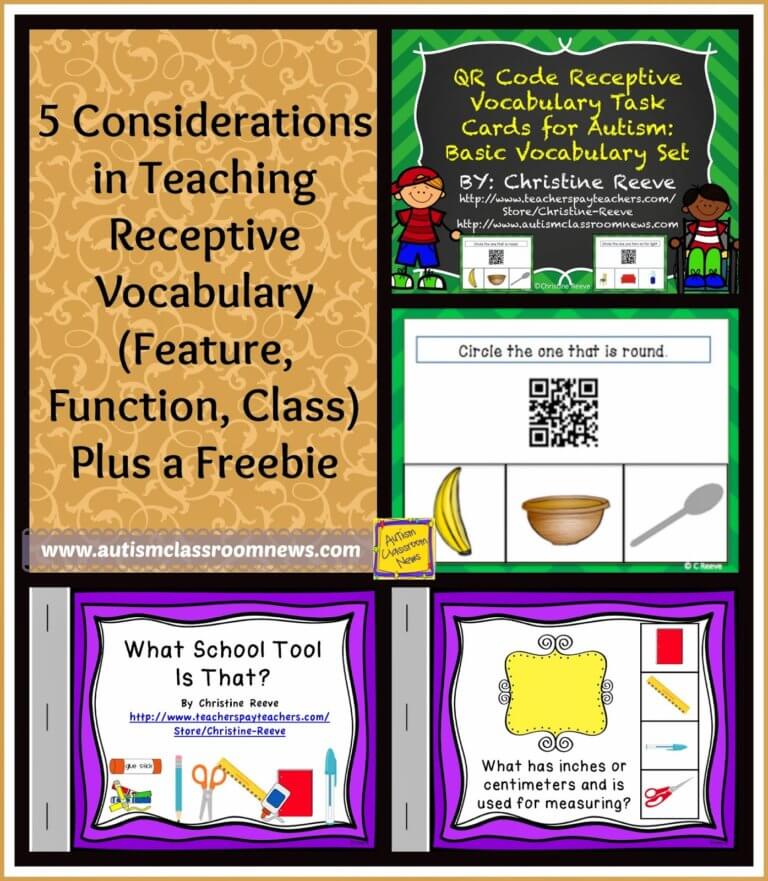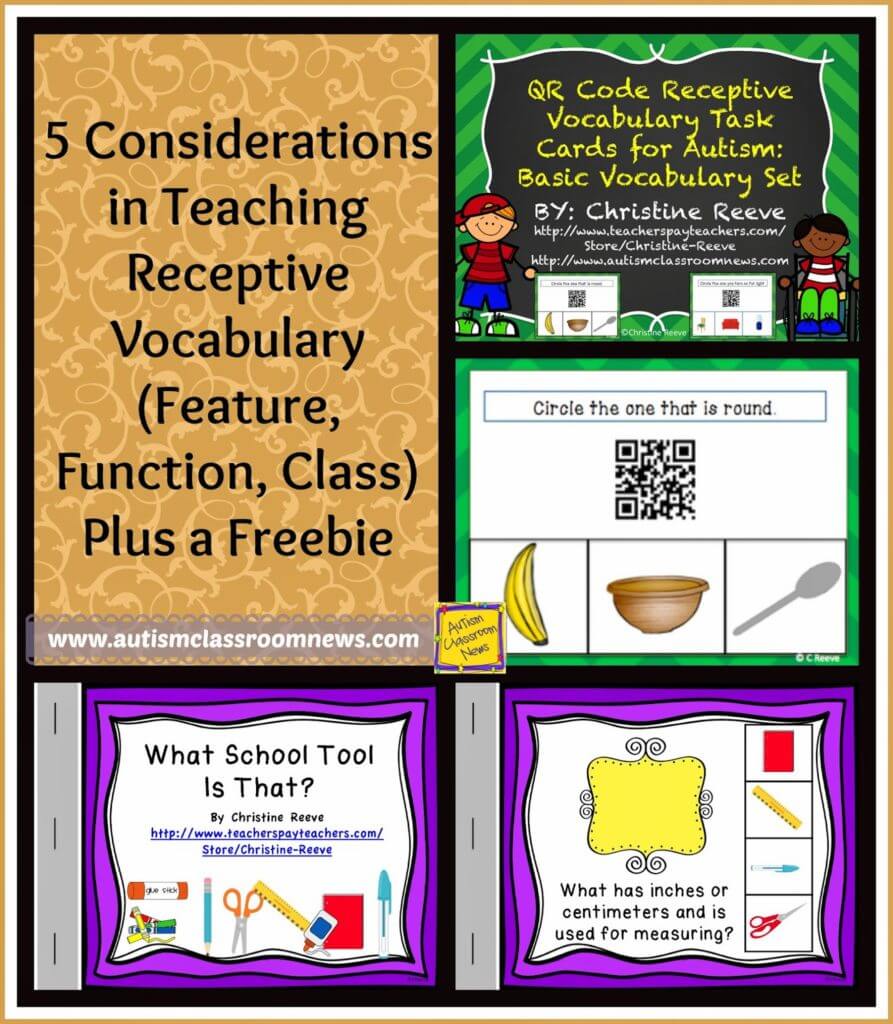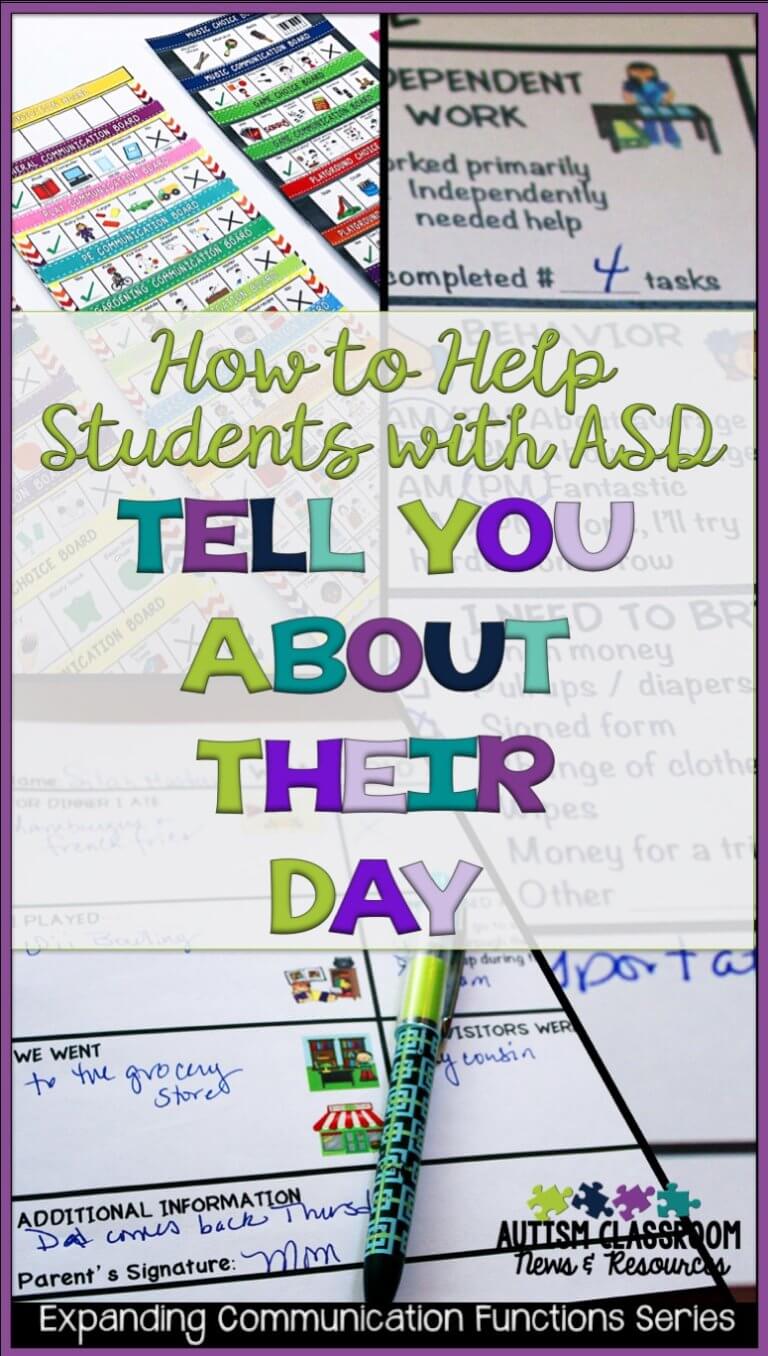I have been very busy this weekend with the extension of an earlier idea…but like most of my ideas, it has expanded into multiple concepts. And while I was creating it, I got to thinking about some of the key points to remember in teaching vocabulary to students (regardless of their age). So, schedule says, first I want to talk about teaching vocabulary, then I’ll share the newest product, and then there is a related freebie. So get a beverage of choice and I’ll get started.
While we know that teaching students with autism vocabulary is not enough to get them to communicate, we also know that just being able to identify and label vocabulary is not enough to supplement their communication. One of the early focuses of programming for students with autism is teaching different functions of language. We start with requesting, move on to labeling and then to use of language with less direct reinforcement including commenting, questioning, answering questions and other functions. In order to build larger repertoires of language skills, students have to expand their vocabulary beyond labeling and requesting which includes being able to recognize and identify different characteristics of things in their environment. We often start by teaching these as features (i.e., adjectives), functions (i.e., use), and class (i.e., categories). We teach them receptively and expressively, hence RFFC (receptive feature, function, class) and EFFC (which is used less often). However, when we focus on teaching FFC we need to make sure that we are teaching with the focus on the function for the student which leads me to the 5 things to think about.
1. Focus on vocabulary that are meaningful for the student
To me this is the most important. It’s easy to try to teach every vocabulary picture in the Language Builder box. However, what vocabulary does the student really need to know? Does he need to know giraffe and zebra and the one with the long neck and the one with stripes? Probably not unless he is going to the zoo. So, make sure that he can talk about the items in his everyday environment (e.g., his desk, his bed, his notebook). When he can talk about those with FFCs then we can move on to more outlying vocabulary like zoo animals.
2. Make sure you are teaching vocabulary in a meaningful way.
We can teach vocabulary using discrete trials at a desk as ONE strategy, but that can’t be our only strategy. In order for the vocabulary to be useful, the students have to be using the vocabulary in a meaningful way. So we can start by having them request things by color and size, and then move on to finding things in their environment by characteristic or function (e.g., find the thing you sleep in) and then describing things they see.
3. Make sure you mix up the characteristics you teach
It’s very easy for this type of teaching to become rote and the students to fall into patterns where the one with a tail is always a dog. Or the dog is always described as having a tail but not as having 4 legs, fur, and barking or as an animal, a mammal, etc. Mix it up so that items have more than one characteristic and the characteristics change. I’ll never forget a student I had who just started to request his favorite candy as “I want a yellow, soft Starburst please.” That became it’s name rather than his choosing those words when making the request because we didn’t put enough variety into the teaching.
4. Use lots of examples
Students with autism have particular difficulty with focusing on irrelevant characteristics of items as being the key components. For example, if we teach a student about dogs by always focusing on dogs being brown (brown pictures, which one is brown, etc.), don’t be surprised when he sees a black dog and doesn’t identify it as a dog. So, make sure you use lots of examples of the items–lots of different pictures (illustrations, photos and real items), that you are talking about the items as you encounter them in the real world, and that you are teaching each item with multiple characteristics.
5. Teach vocabulary in lots of different ways
Not only do we need to focus on lots of different examples with lots of varied characteristics, we also need to teach them in a variety of ways. Teach vocabulary by having them request items in different ways, by finding pictures in books, buy finding items in their everyday environment, by using discrete trials with picture cards, and as many other ways as you can think of to expose the child to the targeted vocabulary. This teaches the most flexibility in its use as well as enhances generalization and makes it fun. And as we know, students who have fun in instruction are more likely to stay engaged.
New Product
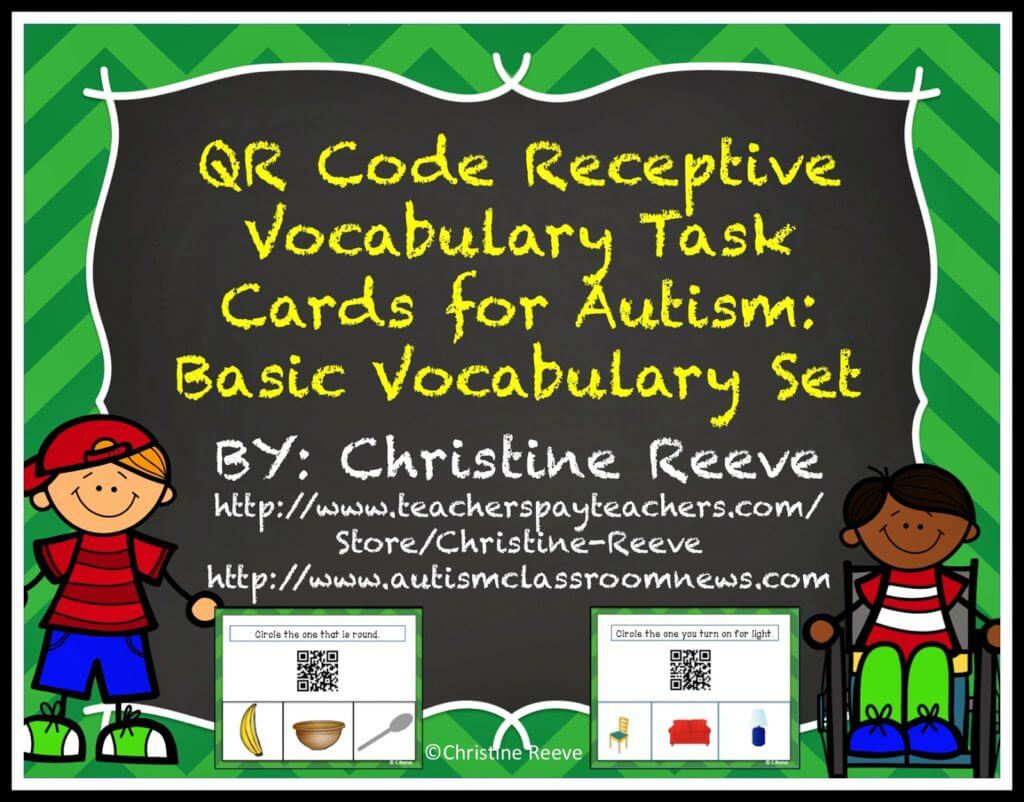
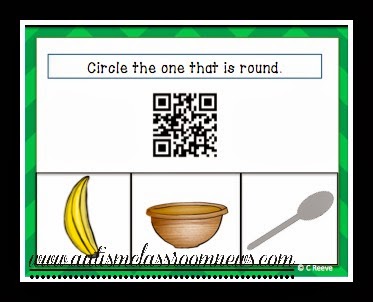 So, that brings me to my new product which is designed to help students practice RFFCs in their independent work systems. Back in September, I talked about the use of language masters or card readers in the use of teaching vocabulary in classrooms and created a freebie of RFFC task cards. You can read about it and find the link to the freebie HERE. This new product is an extension of that freebie. It is a set of 88 multiple choice task cards that focus on either feature, function or category of common vocabulary. I focused primarily on the vocabulary students experience everyday at home and at school with a few foods and pets for variety. You can see a list of the vocabulary targeted in the preview of the item on TPT. The picture to the right is one of the task cards. Essentially the students scan the QR code and it reads the text at the top (e.g., Circle the one that is round.) Then the student circles the item that has that characteristic (in this case the bowl). The cards are designed to be mixed up and have several different illustrations for each item to present several examples. These are designed to be used for students to practice skills they have been taught. You will still need to teach the characteristics in explicit instruction using a variety of materials, of which these could be one but not all. These are designed to help students practice the skills on their own. Clearly they are practicing receptive skills by circling the items not expressive skills, so again those need to be taught in different ways. However, they are designed to meet #1 above by focusing on common everyday vocabulary and they are one way to reinforce the vocabulary for items #3, 4 and 5 above. In the future I plan to expand with more task cards focused on different thematic vocabulary (e.g., cooking vocabulary, spring vocabulary) that will build on this package.
So, that brings me to my new product which is designed to help students practice RFFCs in their independent work systems. Back in September, I talked about the use of language masters or card readers in the use of teaching vocabulary in classrooms and created a freebie of RFFC task cards. You can read about it and find the link to the freebie HERE. This new product is an extension of that freebie. It is a set of 88 multiple choice task cards that focus on either feature, function or category of common vocabulary. I focused primarily on the vocabulary students experience everyday at home and at school with a few foods and pets for variety. You can see a list of the vocabulary targeted in the preview of the item on TPT. The picture to the right is one of the task cards. Essentially the students scan the QR code and it reads the text at the top (e.g., Circle the one that is round.) Then the student circles the item that has that characteristic (in this case the bowl). The cards are designed to be mixed up and have several different illustrations for each item to present several examples. These are designed to be used for students to practice skills they have been taught. You will still need to teach the characteristics in explicit instruction using a variety of materials, of which these could be one but not all. These are designed to help students practice the skills on their own. Clearly they are practicing receptive skills by circling the items not expressive skills, so again those need to be taught in different ways. However, they are designed to meet #1 above by focusing on common everyday vocabulary and they are one way to reinforce the vocabulary for items #3, 4 and 5 above. In the future I plan to expand with more task cards focused on different thematic vocabulary (e.g., cooking vocabulary, spring vocabulary) that will build on this package.
You can check out the new product, including a list of targets in the preview, HERE at my TPT store.
FREEBIE!!
And that brings me to the freebie. To help build vocabulary and to expand the ways you are teaching vocabulary, I have created the adapted book below. You can read the book with the students and have them identify the book and Velcro it to the center piece. I will make more of these for the store, but I wanted to share this one which has varied vocabulary of school tools. Click the picture below to download the freebie. I will be probably be writing more of these and more of the task cards above. Have vocabulary or topics you would like me to focus on? Please leave me a comment and let me know.
So, in the meantime, check out more freebies at Manic Monday, Freebie Friday and Speechie Freebies!
Until next time,

